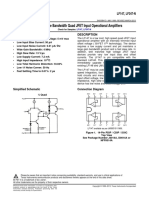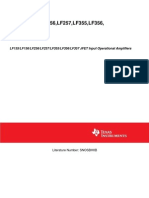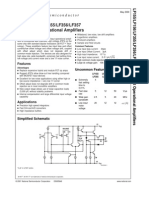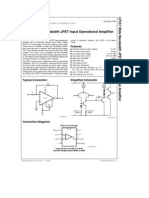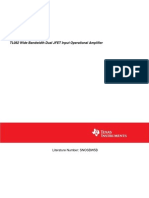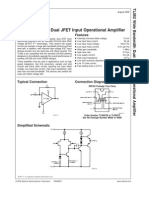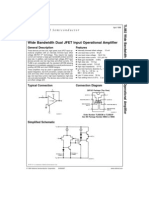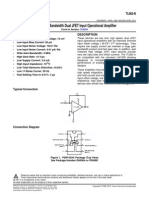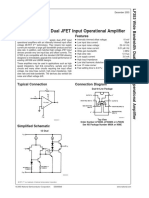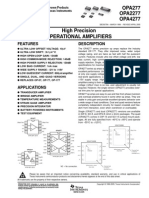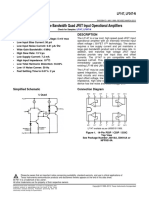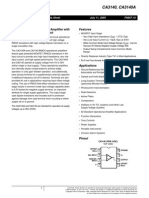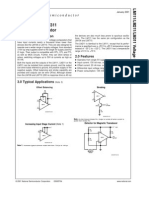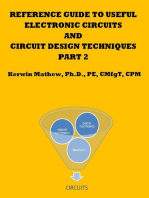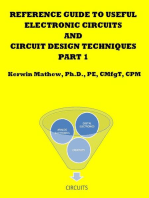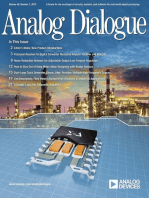LF347BN
LF347BN
Uploaded by
David Emmanuel Contreras MadrigalCopyright:
Available Formats
LF347BN
LF347BN
Uploaded by
David Emmanuel Contreras MadrigalCopyright
Available Formats
Share this document
Did you find this document useful?
Is this content inappropriate?
Copyright:
Available Formats
LF347BN
LF347BN
Uploaded by
David Emmanuel Contreras MadrigalCopyright:
Available Formats
LF147/LF347 Wide Bandwidth Quad JFET Input Operational Amplifiers
August 2000
LF147/LF347 Wide Bandwidth Quad JFET Input Operational Amplifiers
General Description
The LF147 is a low cost, high speed quad JFET input operational amplifier with an internally trimmed input offset voltage (BI-FET II technology). The device requires a low supply current and yet maintains a large gain bandwidth product and a fast slew rate. In addition, well matched high voltage JFET input devices provide very low input bias and offset currents. The LF147 is pin compatible with the standard LM148. This feature allows designers to immediately upgrade the overall performance of existing LF148 and LM124 designs. The LF147 may be used in applications such as high speed integrators, fast D/A converters, sample-and-hold circuits and many other circuits requiring low input offset voltage, low input bias current, high input impedance, high slew rate and wide bandwidth. The device has low noise and offset voltage drift.
Features
n n n n n n n n n n Internally trimmed offset voltage: Low input bias current: Low input noise current: Wide gain bandwidth: High slew rate: Low supply current: High input impedance: Low total harmonic distortion: Low 1/f noise corner: Fast settling time to 0.01%: 5 mV max 50 pA 0.01 pA/Hz 4 MHz 13 V/s 7.2 mA 1012 0.02% 50 Hz 2 s
Simplified Schematic
14
Connection Diagram
Dual-In-Line Package
Quad
00564701
Note 1: LF147 available as per JM38510/11906.
00564713
Top View Order Number LF147J, LF147J-SMD, LF347M, LF347BN, LF347N, LF147J/883, or JL147 BCA (Note 1) See NS Package Number J14A, M14A or N14A
BI-FET II is a trademark of National Semiconductor Corporation.
2004 National Semiconductor Corporation
DS005647
www.national.com
LF147/LF347
Absolute Maximum Ratings (Note 2)
If Military/Aerospace specified devices are required, please contact the National Semiconductor Sales Office/ Distributors for availability and specifications. LF147 Supply Voltage Differential Input Voltage Input Voltage Range (Note 3) Output Short Circuit Duration (Note 4) Power Dissipation (Notes 5, 11) Tj max jA Ceramic DIP (J) Package Plastic DIP (N) Package Surface Mount Narrow (M) Surface Mount Wide (WM) 70C/W 75C/W 100C/W 85C/W (Note 7) Conditions Min VOS Input Offset Voltage RS=10 k, TA=25C Over Temperature VOS/T Average TC of Input Offset Voltage IOS IB RIN AVOL Input Offset Current Input Bias Current Input Resistance Large Signal Voltage Gain Tj=25C, (Notes 7, 8) Over Temperature Tj=25C, (Notes 7, 8) Over Temperature Tj=25C VS= 15V, TA=25C VO= 10V, RL=2 k Over Temperature VO VCM CMRR PSRR IS Output Voltage Swing Input Common-Mode Voltage Range Common-Mode Rejection Ratio Supply Voltage Rejection Ratio Supply Current RS10 k (Note 9) 80 80 VS= 15V, RL=10 k VS= 15V 25 25 50 10
12
LF147 Operating Temperature Range Storage Temperature Range Lead Temperature (Soldering, 10 sec.) Soldering Information Dual-In-Line Package Soldering (10 seconds) Small Outline Package Vapor Phase (60 seconds) Infrared (15 seconds) 260C (Note 6)
LF347B/LF347 (Note 6)
LF347B/LF347
65CTA150C 260C
22V 38V 19V
Continuous 900 mW 150C
18V 30V 15V
Continuous 1000 mW 150C
260C 215C 220C
See AN-450 Surface Mounting Methods and Their Effect on Product Reliability for other methods of soldering surface mount devices. ESD Tolerance (Note 12) 900V
DC Electrical Characteristics
Symbol Parameter
LF147 Typ Max Min 1 10 25 50 100 25 200 50 5 8
LF347B Typ Max Min 3 10 25 50 10 50
12
LF347 Typ Max 5 10 100 4 200 8 10 25 15
12
Units 10 13 mV mV V/C 100 4 200 8 pA nA pA nA V/mV V/mV V V V dB dB 11 mA
5 7
RS=10 k
25 50
100
100
100
12 13.5 11 +15
12 100 100 7.2 11
12 13.5 11 +15
12 80 80 100 100 7.2 11
12 13.5 11 +15
12 70 70 100 100 7.2
www.national.com
LF147/LF347
AC Electrical Characteristics
Symbol Parameter Amplifier to Amplifier Coupling
(Note 7) LF147 Min Typ Max Min 120 LF347B Typ Max Min 120 LF347 Typ Max 120 dB Units
Conditions TA=25C, f=1 Hz20 kHz (Input Referred)
SR GBW en
Slew Rate Gain-Bandwidth Product Equivalent Input Noise Voltage
VS= 15V, TA=25C VS= 15V, TA=25C TA=25C, RS=100, f=1000 Hz
8 2.2
13 4 20
8 2.2
13 4 20
8 2.2
13 4 20
V/s MHz
in THD
Equivalent Input Noise Current Total Harmonic Distortion
Tj=25C, f=1000 Hz AV=+10, RL=10k, VO=20 Vp-p, BW=20 Hz20 kHz
0.01
0.01
0.01
< 0.02
< 0.02
< 0.02
Note 2: Absolute Maximum Ratings indicate limits beyond which damage to the device may occur. Operating Ratings indicate conditions for which the device is functional, but do not guarantee specific performance limits. Note 3: Unless otherwise specified the absolute maximum negative input voltage is equal to the negative power supply voltage. Note 4: Any of the amplifier outputs can be shorted to ground indefinitely, however, more than one should not be simultaneously shorted as the maximum junction temperature will be exceeded. Note 5: For operating at elevated temperature, these devices must be derated based on a thermal resistance of jA. Note 6: The LF147 is available in the military temperature range 55CTA125C, while the LF347B and the LF347 are available in the commercial temperature range 0CTA70C. Junction temperature can rise to Tj max = 150C. Note 7: Unless otherwise specified the specifications apply over the full temperature range and for VS= 20V for the LF147 and for VS= 15V for the LF347B/LF347. VOS, IB, and IOS are measured at VCM=0. Note 8: The input bias currents are junction leakage currents which approximately double for every 10C increase in the junction temperature, Tj. Due to limited production test time, the input bias currents measured are correlated to junction temperature. In normal operation the junction temperature rises above the ambient temperature as a result of internal power dissipation, PD. Tj=TA+jA PD where jA is the thermal resistance from junction to ambient. Use of a heat sink is recommended if input bias current is to be kept to a minimum. Note 9: Supply voltage rejection ratio is measured for both supply magnitudes increasing or decreasing simultaneously in accordance with common practice from VS = 5V to 15V for the LF347 and LF347B and from VS = 20V to 5V for the LF147. Note 10: Refer to RETS147X for LF147D and LF147J military specifications. Note 11: Max. Power Dissipation is defined by the package characteristics. Operating the part near the Max. Power Dissipation may cause the part to operate outside guaranteed limits. Note 12: Human body model, 1.5 k in series with 100 pF.
www.national.com
LF147/LF347
Typical Performance Characteristics
Input Bias Current Input Bias Current
00564714
00564715
Supply Current
Positive Common-Mode Input Voltage Limit
00564716 00564717
Negative Common-Mode Input Voltage Limit
Positive Current Limit
00564719 00564718
www.national.com
LF147/LF347
Typical Performance Characteristics
Negative Current Limit
(Continued) Output Voltage Swing
00564720
00564721
Output Voltage Swing
Gain Bandwidth
00564722
00564723
Bode Plot
Slew Rate
00564724
00564725
www.national.com
LF147/LF347
Typical Performance Characteristics
Distortion vs Frequency
(Continued) Undistorted Output Voltage Swing
00564726
00564727
Open Loop Frequency Response
Common-Mode Rejection Ratio
00564728
00564729
Power Supply Rejection Ratio
Equivalent Input Noise Voltage
00564730
00564731
www.national.com
LF147/LF347
Typical Performance Characteristics
Open Loop Voltage Gain
(Continued) Output Impedance
00564732
00564733
Inverter Settling Time
00564734
www.national.com
LF147/LF347
Pulse Response
RL=2 k, CL=10 pF
Large Signal Inverting
Small Signal Inverting
00564706
00564704
Large Signal Non-Inverting
Small Signal Non-Inverting
00564707
00564705
Current Limit (RL=100)
00564708
Application Hints
The LF147 is an op amp with an internally trimmed input offset voltage and JFET input devices (BI-FET II). These JFETs have large reverse breakdown voltages from gate to source and drain eliminating the need for clamps across the inputs. Therefore, large differential input voltages can easily be accommodated without a large increase in input current. The maximum differential input voltage is independent of the supply voltages. However, neither of the input voltages
should be allowed to exceed the negative supply as this will cause large currents to flow which can result in a destroyed unit. Exceeding the negative common-mode limit on either input will force the output to a high state, potentially causing a reversal of phase to the output. Exceeding the negative common-mode limit on both inputs will force the amplifier output to a high state. In neither case does a latch occur since raising the input back within the common-mode range again puts the input stage and thus the amplifier in a normal operating mode.
www.national.com
LF147/LF347
Application Hints
(Continued)
Exceeding the positive common-mode limit on a single input will not change the phase of the output; however, if both inputs exceed the limit, the output of the amplifier will be forced to a high state. The amplifiers will operate with a common-mode input voltage equal to the positive supply; however, the gain bandwidth and slew rate may be decreased in this condition. When the negative common-mode voltage swings to within 3V of the negative supply, an increase in input offset voltage may occur. Each amplifier is individually biased by a zener reference which allows normal circuit operation on 4.5V power supplies. Supply voltages less than these may result in lower gain bandwidth and slew rate. The LF147 will drive a 2 k load resistance to 10V over the full temperature range. If the amplifier is forced to drive heavier load currents, however, an increase in input offset voltage may occur on the negative voltage swing and finally reach an active current limit on both positive and negative swings. Precautions should be taken to ensure that the power supply for the integrated circuit never becomes reversed in polarity or that the unit is not inadvertently installed backwards in a
socket as an unlimited current surge through the resulting forward diode within the IC could cause fusing of the internal conductors and result in a destroyed unit. As with most amplifiers, care should be taken with lead dress, component placement and supply decoupling in order to ensure stability. For example, resistors from the output to an input should be placed with the body close to the input to minimize pick-up and maximize the frequency of the feedback pole by minimizing the capacitance from the input to ground. A feedback pole is created when the feedback around any amplifier is resistive. The parallel resistance and capacitance from the input of the device (usually the inverting input) to AC ground set the frequency of the pole. In many instances the frequency of this pole is much greater than the expected 3 dB frequency of the closed loop gain and consequently there is negligible effect on stability margin. However, if the feedback pole is less than approximately 6 times the expected 3 dB frequency a lead capacitor should be placed from the output to the input of the op amp. The value of the added capacitor should be such that the RC time constant of this capacitor and the resistance it parallels is greater than or equal to the original feedback pole time constant.
Detailed Schematic
00564709
www.national.com
LF147/LF347
Typical Applications
Digitally Selectable Precision Attenuator
00564710
All resistors 1% tolerance
Accuracy of better than 0.4% with standard 1% value resistors No offset adjustment necessary Expandable to any number of stages Very high input impedance
A1 0 0 0 0 1 1 1 1 A2 0 0 1 1 0 0 1 1 A3 0 1 0 1 0 1 0 1 VO Attenuation 0 1 dB 2 dB 3 dB 4 dB 5 dB 6 dB 7 dB
www.national.com
10
LF147/LF347
Typical Applications
(Continued)
Long Time Integrator with Reset, Hold and Starting Threshold Adjustment
00564711
VOUT starts from zero and is equal to the integral of the input voltage with respect to the threshold voltage:
Output starts when VINVTH Switch S1 permits stopping and holding any output value Switch S2 resets system to zero
11
www.national.com
LF147/LF347
Typical Applications
(Continued) Universal State Variable Filter
00564712
For circuit shown: fo=3 kHz, fNOTCH=9.5 kHz Q=3.4 Passband gain: Highpass 0.1 Bandpass 1 Lowpass 1 Notch 10
foxQ200 kHz 10V peak sinusoidal output swing without slew limiting to 200 kHz See LM148 data sheet for design equations
www.national.com
12
LF147/LF347
Physical Dimensions
inches (millimeters) unless otherwise noted
Ceramic Dual-In-Line Package (J) Order Number LF147J, LM147J-SMD or LF147J/883 NS Package Number J14A
S.O. Package (M) Order Number LF347M or LF347MX NS Package Number M14A
13
www.national.com
LF147/LF347 Wide Bandwidth Quad JFET Input Operational Amplifiers
Physical Dimensions
inches (millimeters) unless otherwise noted (Continued)
Molded Dual-In-Line Package (N) Order Number LF347BN or LF347N NS Package Number N14A
LIFE SUPPORT POLICY NATIONALS PRODUCTS ARE NOT AUTHORIZED FOR USE AS CRITICAL COMPONENTS IN LIFE SUPPORT DEVICES OR SYSTEMS WITHOUT THE EXPRESS WRITTEN APPROVAL OF THE PRESIDENT AND GENERAL COUNSEL OF NATIONAL SEMICONDUCTOR CORPORATION. As used herein: 1. Life support devices or systems are devices or systems which, (a) are intended for surgical implant into the body, or (b) support or sustain life, and whose failure to perform when properly used in accordance with instructions for use provided in the labeling, can be reasonably expected to result in a significant injury to the user. BANNED SUBSTANCE COMPLIANCE National Semiconductor certifies that the products and packing materials meet the provisions of the Customer Products Stewardship Specification (CSP-9-111C2) and the Banned Substances and Materials of Interest Specification (CSP-9-111S2) and contain no Banned Substances as defined in CSP-9-111S2.
National Semiconductor Americas Customer Support Center Email: new.feedback@nsc.com Tel: 1-800-272-9959 www.national.com National Semiconductor Europe Customer Support Center Fax: +49 (0) 180-530 85 86 Email: europe.support@nsc.com Deutsch Tel: +49 (0) 69 9508 6208 English Tel: +44 (0) 870 24 0 2171 Franais Tel: +33 (0) 1 41 91 8790 National Semiconductor Asia Pacific Customer Support Center Email: ap.support@nsc.com National Semiconductor Japan Customer Support Center Fax: 81-3-5639-7507 Email: jpn.feedback@nsc.com Tel: 81-3-5639-7560
2. A critical component is any component of a life support device or system whose failure to perform can be reasonably expected to cause the failure of the life support device or system, or to affect its safety or effectiveness.
National does not assume any responsibility for use of any circuitry described, no circuit patent licenses are implied and National reserves the right at any time without notice to change said circuitry and specifications.
This datasheet has been download from: www.datasheetcatalog.com Datasheets for electronics components.
You might also like
- KVM PPT For CustomersDocument17 pagesKVM PPT For CustomerskarunakaraNo ratings yet
- Workbook B2 Unit4Document10 pagesWorkbook B2 Unit4Estefanía H'VeNo ratings yet
- LF347n PDFDocument13 pagesLF347n PDFDiego PeñuelaNo ratings yet
- lf347 NDocument21 pageslf347 NEda UluNo ratings yet
- Datasheet LF412CNDocument14 pagesDatasheet LF412CNJose Fernando Perdomo BolañosNo ratings yet
- LM356Document25 pagesLM356Wilfredo Paniagua OrellanaNo ratings yet
- LF155Document24 pagesLF155Brzata PticaNo ratings yet
- LF442Document14 pagesLF442atavachronNo ratings yet
- LF444 Quad Low Power JFET Input Operational Amplifier: General Description FeaturesDocument11 pagesLF444 Quad Low Power JFET Input Operational Amplifier: General Description FeaturesJohn PachecoNo ratings yet
- LF442CNDocument13 pagesLF442CNFSNo ratings yet
- LM148/LM248/LM348 Quad 741 Op Amps: General DescriptionDocument4 pagesLM148/LM248/LM348 Quad 741 Op Amps: General DescriptionJunedy Pandapotan SaragihNo ratings yet
- LF353Document13 pagesLF353cromus_9000No ratings yet
- LF351NDocument11 pagesLF351NAndres CampoNo ratings yet
- TL082 EqualizerDocument16 pagesTL082 EqualizerMecabot DzibNo ratings yet
- TL082Document14 pagesTL082radioscribdNo ratings yet
- OpAmp - LF451Document8 pagesOpAmp - LF451Ludwig SchmidtNo ratings yet
- Tl082cp Datasheet de National Semiconductor para Sustituir Ci de Etapa Pre Amplificador Bunker Mx2400 2Document12 pagesTl082cp Datasheet de National Semiconductor para Sustituir Ci de Etapa Pre Amplificador Bunker Mx2400 2Jess AJNo ratings yet
- tl082 Op Amp DatasheetDocument23 pagestl082 Op Amp DatasheetnurburgNo ratings yet
- FSFR1800Document17 pagesFSFR1800sontuyet82No ratings yet
- High Efficiency Low-Side N-Channel Controller For Switching RegulatorsDocument33 pagesHigh Efficiency Low-Side N-Channel Controller For Switching Regulatorssoft4gsmNo ratings yet
- LM3478 High Efficiency Low-Side N-Channel Controller For Switching RegulatorDocument22 pagesLM3478 High Efficiency Low-Side N-Channel Controller For Switching RegulatorVinoth Kumar RajendranNo ratings yet
- Datasheet LF 353Document14 pagesDatasheet LF 353Anggridho MeilandanuNo ratings yet
- TL081Document9 pagesTL081Vero PorrasNo ratings yet
- FSFR1700XSLDocument14 pagesFSFR1700XSLАлександр АндриановNo ratings yet
- LM318HDocument19 pagesLM318HAlberto MarsicoNo ratings yet
- tl082cp DatasheetDocument15 pagestl082cp DatasheetHeriberto Flores AmpieNo ratings yet
- Opa 2277Document27 pagesOpa 2277Nathalie CauchiNo ratings yet
- Datsasheet of LM347 IcDocument24 pagesDatsasheet of LM347 IcShubhamMittalNo ratings yet
- LF147/LF347 Wide Bandwidth Quad JFET Input Operational AmplifiersDocument21 pagesLF147/LF347 Wide Bandwidth Quad JFET Input Operational AmplifiersCristian RodriguezNo ratings yet
- LF147/LF347 Wide Bandwidth Quad JFET Input Operational AmplifiersDocument24 pagesLF147/LF347 Wide Bandwidth Quad JFET Input Operational AmplifiersJorge Ballesteros CaceresNo ratings yet
- LF147-LF347 Texas InstrumentDocument21 pagesLF147-LF347 Texas InstrumentCarlos VazquezNo ratings yet
- Opa 277Document27 pagesOpa 277Wahyu PalanchoiNo ratings yet
- EL7585AILDocument18 pagesEL7585AILsorintvrNo ratings yet
- Ca3140 ADocument23 pagesCa3140 AvjchandrarNo ratings yet
- Datasheet 1Document18 pagesDatasheet 1shashwatthakurNo ratings yet
- Dioda Laser 3 PDFDocument11 pagesDioda Laser 3 PDFprima_fajar13No ratings yet
- LM2727/LM2737 N-Channel FET Synchronous Buck Regulator Controller For Low Output VoltagesDocument22 pagesLM2727/LM2737 N-Channel FET Synchronous Buck Regulator Controller For Low Output VoltagesselocaNo ratings yet
- LF 351Document14 pagesLF 351Ivan PetrovicNo ratings yet
- Datasheet (LT1074)Document16 pagesDatasheet (LT1074)HermesSanchezNo ratings yet
- White LED Driver With Wide PWM Dimming Range Features: FN6264.3 Data Sheet March 7, 2008Document10 pagesWhite LED Driver With Wide PWM Dimming Range Features: FN6264.3 Data Sheet March 7, 2008ram12krishnaNo ratings yet
- LM311Document23 pagesLM311Brzata PticaNo ratings yet
- LM 118Document15 pagesLM 118SaadAhmedBeihaqiNo ratings yet
- OP200Document16 pagesOP200Bharadwaj NandirajuNo ratings yet
- AP2182Document17 pagesAP2182ابراهيم السعيديNo ratings yet
- LTC 7138Document24 pagesLTC 7138MallickarjunaNo ratings yet
- LM3404Document28 pagesLM3404Radu CaramaliuNo ratings yet
- LM 4755Document18 pagesLM 4755Ovidio RiosNo ratings yet
- LM5007 High Voltage (80V) Step Down Switching Regulator: FeaturesDocument17 pagesLM5007 High Voltage (80V) Step Down Switching Regulator: FeaturesbhushanchittaragiNo ratings yet
- Features General Description: USB Power-Distribution SwitchesDocument21 pagesFeatures General Description: USB Power-Distribution SwitchesgraynotNo ratings yet
- EUP3475A Chip in JVC KW-M24BTDocument11 pagesEUP3475A Chip in JVC KW-M24BTdjts669pw2No ratings yet
- LM194, LM394: LM194 LM394 Supermatch PairDocument12 pagesLM194, LM394: LM194 LM394 Supermatch Pairglot420No ratings yet
- Reference Guide To Useful Electronic Circuits And Circuit Design Techniques - Part 2From EverandReference Guide To Useful Electronic Circuits And Circuit Design Techniques - Part 2No ratings yet
- Reference Guide To Useful Electronic Circuits And Circuit Design Techniques - Part 1From EverandReference Guide To Useful Electronic Circuits And Circuit Design Techniques - Part 1Rating: 2.5 out of 5 stars2.5/5 (3)
- Analog Dialogue Volume 46, Number 1: Analog Dialogue, #5From EverandAnalog Dialogue Volume 46, Number 1: Analog Dialogue, #5Rating: 5 out of 5 stars5/5 (1)
- A Guide to Vintage Audio Equipment for the Hobbyist and AudiophileFrom EverandA Guide to Vintage Audio Equipment for the Hobbyist and AudiophileNo ratings yet
- Analog Dialogue, Volume 48, Number 1: Analog Dialogue, #13From EverandAnalog Dialogue, Volume 48, Number 1: Analog Dialogue, #13Rating: 4 out of 5 stars4/5 (1)
- Parakh Questions IIDocument15 pagesParakh Questions IIketankumar30338No ratings yet
- Ohm's Law ExplanationDocument2 pagesOhm's Law ExplanationgbodhiNo ratings yet
- Brochure-BAC-B-BAC00-310-EN 5Document1 pageBrochure-BAC-B-BAC00-310-EN 5Multitech InternationalNo ratings yet
- Cyber Psychology GlossaryDocument8 pagesCyber Psychology GlossaryMiss RoyNo ratings yet
- Essay Packet Compare ContrastDocument3 pagesEssay Packet Compare Contrastelizabeth_lenherrNo ratings yet
- Agv Lift Agv Automated Container Transport Proven Technology From GottwaldDocument8 pagesAgv Lift Agv Automated Container Transport Proven Technology From GottwaldHậu PhạmNo ratings yet
- William SlidesCarnivalDocument29 pagesWilliam SlidesCarnivalHeaven LindenNo ratings yet
- PTB 311E / 511E / 311E-800: Manual 3-In-1 Tablet Testing InstrumentDocument6 pagesPTB 311E / 511E / 311E-800: Manual 3-In-1 Tablet Testing InstrumentLiton Kumar BiswasNo ratings yet
- Euro Air RR Case Study PDFDocument2 pagesEuro Air RR Case Study PDFDenise Koh Chin HuiNo ratings yet
- SCM Final ReportDocument12 pagesSCM Final ReportSYED DANIYAL HASSAN SHAHNo ratings yet
- Suresh Thevar: AchievementsDocument2 pagesSuresh Thevar: Achievementssuresh thevarNo ratings yet
- Nur Syifa Azrya - ResumeDocument3 pagesNur Syifa Azrya - Resumenur ali fahmiNo ratings yet
- Draft Product Manual ToysDocument44 pagesDraft Product Manual ToysShejil BalakrishnanNo ratings yet
- Field Work No. 1 Pacing On The GroundDocument11 pagesField Work No. 1 Pacing On The GroundJawahir Gomez33% (6)
- Inner Product Space IITBDocument13 pagesInner Product Space IITBशिवम् सुनील कुमारNo ratings yet
- Methodology For Bitumen MasticDocument6 pagesMethodology For Bitumen MasticSudip MukhopadhyayNo ratings yet
- Soil Nail GeotechnicsDocument20 pagesSoil Nail GeotechnicsKingsley OchiengNo ratings yet
- Cape 2Document5 pagesCape 2api-708673630No ratings yet
- 1) Anacleto Del RosarioDocument22 pages1) Anacleto Del RosariokatemonroidNo ratings yet
- Good and Bad TraitsDocument3 pagesGood and Bad TraitsMadz Elumba ParisNo ratings yet
- E-Katalog NEW PRODUCT MEVAL 2022 PDFDocument6 pagesE-Katalog NEW PRODUCT MEVAL 2022 PDFawaliaNo ratings yet
- Rear Differential LockDocument6 pagesRear Differential LockEsteban LefontNo ratings yet
- Persision Berchon-1Document51 pagesPersision Berchon-1Ahmed SherifNo ratings yet
- PresentDocument22 pagesPresentAniqy MarshallNo ratings yet
- HSUPA Enhancements: Soc Classification Level 1 © Nokia Siemens NetworksDocument61 pagesHSUPA Enhancements: Soc Classification Level 1 © Nokia Siemens NetworksTry TestNo ratings yet
- CcappDocument13 pagesCcappTheHotPoolGirlNo ratings yet
- CHP - V Sight DistancerDocument26 pagesCHP - V Sight Distancerሽታ ዓለሜ0% (1)
- Uts Cmo Module 5Document31 pagesUts Cmo Module 5Ceelinah EsparazNo ratings yet




